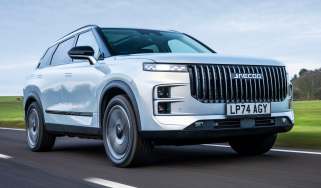Hyundai Santa Fe review - MPG, running costs & CO2 (2018-2023)
Reasonable fuel economy but the Hyundai Santa Fe could still be expensive to run
The Hyundai Santa Fe offers reasonable fuel economy with low CO2 emissions, but its considerable size and weight mean maintenance and running costs might still prove expensive. Thankfully, you shouldn't have too many worries if something goes wrong, as Hyundai's warranty is one of the best in the industry.
Hyundai Santa Fe MPG & CO2
You can choose a 2.2-litre diesel engine again in the Santa Fe, although the showroom staff might try and push you towards one of the hybrid models. At the time of writing, Hyundai hasn’t revealed fuel efficiency figures for the diesel, but the same engine in the previous Santa Fe managed up to 40mpg. If you’re a high-mileage driver or regularly tow heavy loads, the diesel will still suit, but many drivers will be better off in the hybrid.
The hybrid version is more affordable than the plug-in hybrid because it's fitted with a much smaller 1.49kWh battery, which is charged via regeneration and the combustion engine only.
Buyers can choose the hybrid with front or four-wheel drive, and we'd recommend sticking with two-wheel drive unless you think you'll need the extra traction regularly. That's because it sees the official figure of up to 44.1mpg in the entry-level Premium trim fall to just 38.2mpg in the Ultimate version. CO2 emissions also climb from 145g/km to 168g/km, so despite this Santa Fe's hybrid powertrain, it will still be expensive for company-car drivers paying Benefit-in-Kind (BiK) tax.
More reviews
With a larger 13.8kWh battery, the Santa Fe PHEV has an electric range of up to 36 miles and needs charging at home or at a public charger. Do this frequently and you'll be rewarded with triple-digit fuel economy; Hyundai claims an official economy figure of 173mpg. Of course, like any PHEV, if you drive further afield without charging the battery, this figure will drop significantly. In a quick test-drive of the plug-in hybrid with its battery depleted, the car was achieving closer to 30mpg, so the PHEV will cost you (or your company) quite a lot to run if you don’t make use of its battery.
Regardless of how charged the battery is, the 37g/km CO2 figure stays the same and ensures a low BiK band, although you no longer get free entry into low emissions zones such as the Congestion Charge in London. You’ll need an electric or hydrogen car if that’s particularly important to you.
VED (road tax) will cost buyers the lower rate, thanks to the Santa Fe's hybrid powertrain, but buyers still face a large surcharge the first five times you have to renew the tax, as this model sits just above the £40,000 threshold. From year seven, annual road tax reverts to the normal rate for hybrid models.
Insurance
The latest Santa Fe may give you cheaper insurance premiums than the model it replaced. Rather than sitting in groups 36-40, the new model starts off in group 22 - about the same as many smaller SUVs - and rises to group 26 for the plug-in hybrid in Premium trim. Ultimate trim is one group higher across the board. This still compares quite well to the Skoda Kodiaq, a car that sits in groups 15-29.
Servicing
Hyundai offers service plans to help keep maintenance costs predictable and will be happy to advise you on a plan that takes your annual mileage into account. Be aware that consumable items such as tyres will be more expensive on a large SUV like the Santa Fe than for many seven-seat MPV alternatives.
Warranty
Hyundai supports every new car sold in the UK with a five-year/unlimited-mileage warranty. Roadside assistance is provided in the first year, and continues if your car is maintained by an authorised Hyundai workshop.
Which Is Best?
Cheapest
- Name1.6 TGDi Hybrid Premium 5dr Auto
- Gearbox typeSemi-auto
- RRP£47,200
Most Economical
- Name1.6 TGDi Plug-in Hybrid Premium 5dr 4WD Auto
- Gearbox typeSemi-auto
- RRP£52,475
Fastest
- Name1.6 TGDi Plug-in Hybrid Premium 5dr 4WD Auto
- Gearbox typeSemi-auto
- RRP£52,475















